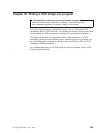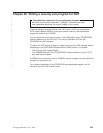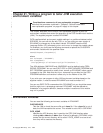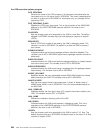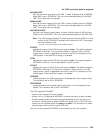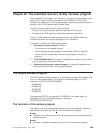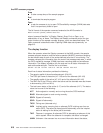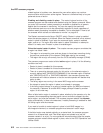MAXHEAPSIZE
Sets the maximum heap size for the JVM, in bytes. A default value of 8000000
bytes (8M) is set in SDFHENV. This is the recommended default for the MVS
JVM. This is above-the-line storage.
MINHEAPSIZE
Sets the minimum heap size for the JVM, in bytes. A default value of 1000000
bytes (1M) is set in SDFHENV. This is the recommended default for the MVS
JVM. This is above-the-line storage.
NATIVESTACKSIZE
Sets the size of each thread’s stack, in bytes. A default value of 262144 bytes
(256K) is set in SDFHENV. This is the recommended default for the MVS JVM.
Note: The initial process thread (IPT) stack is governed by the STACK run-time
option on the DFHCJVM C program that invokes the JVM. This program
sets the following value:
#pragma runopts(STACK(64K,16K,ANYWHERE,KEEP))
STDERR
specifies the name of the HFS file to be used for stderr. The default shipped in
SDFHENV is dfhjvmerr. The file will be created if it does not exist. If the file
already exists, output is appended at the end of the file. On completion of the
JVM program, if the stderr file is empty, it is deleted.
STDIN
specifies the name of the HFS file to be used for stdin. The default shipped in
SDFHENV is dfhjvmin. The will be created if it does not exist.
STDOUT
specifies the name of the HFS file to be used for stdout. The default shipped in
SDFHENV is dfhjvmout. The file will be created if it does not exist. If the file
already exists, output is appended at the end of the file. On completion of the
JVM program, if the stdout file is empty, it is deleted.
VERBOSE
Indicates whether the JVM should issue a message each time it loads a class.
This variable is set to NO in SDFHENV.
VERIFYMODE
Indicates whether the bytecode verifier should be run on all classes that are
loaded. This variable is set to NO in SDFHENV.
The CICS supplied DFHIVMAT:
v Issues getenv requests for each variable.
v Issues a printf to destination MSGUSR, to record the setting of each variable.
v Contains sample code (commented out) demonstrating how to use the setenv
command—including how to append TASKnnnn (where 'nnnn' is the CICS task
number) to the supplied names for stdout and stderr. This shows how to make
unique output and error files for each CICS task.
You can use the supplied DFHIVMAT as an example for your own program.
the JVM execution options program
Chapter 21. Writing a program to tailor JVM execution environment variables 605
|
|
|
|
|
|
|
|
|
|
|
|
|
|
|
|
|
|
|
|
|
|
|
|
|
|
|
|
|
|
|
|
|
|
|
|
|
|
|
|
|
|





